
If Our Church stopped giving birth to its saints, it would become useless in this world, and the doomsday would have arrived. But the Church will give birth to the saints until the last days. Though, they might be not that many in number as they used to be in the previous centuries. Our Church provides us with all the means to live in a spiritual feat and a spiritual joy, and have a spiritual zeal.
We venerate the saints and talk among ourselves, “My patron saint is this one, and I was tonsured and received the name of Saint Antony the Great, and I was called after the Venerable Seraphim of Sarov, and so on…” When we share this joy, we start involuntarily to relate ourselves to these saints and involuntary be proud of this. A little vanity appears deep inside of us, as we bear the name of this or that great saint. In fact, we should have oppositely different thoughts and concerns.
If only we, having the names of great saints and having read their lives many times and seeing the purity of them, would start to compare our inner state to the life of the saints, then we would have had drastically different attitude to our acts and feats, and the whole life…
Archpriest Sergiy Baranov
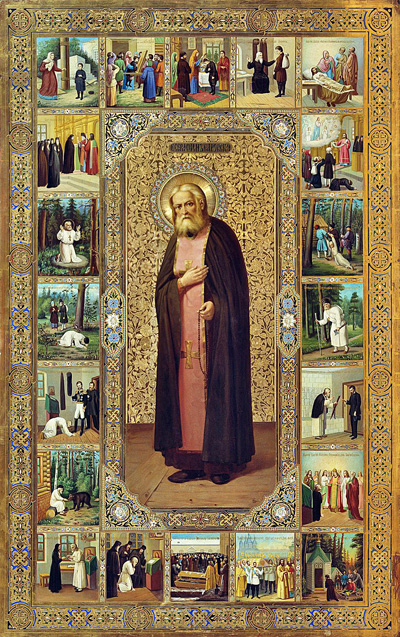
The Venerable Saint Seraphim of Sarov
(1754/9–1833)
The name of the Venerable Seraphim of Sarov is familiar to any Russian. Dozens of books and films about him have been issued. Thousands of people came to see him in his lifetime. And millions – after his death. His prayer before God protects our Homeland, saves and heals great number of people. Every person should know the life of Saint Elder Seraphim, learn Faith and Love from him and imitate his wisdom.
Long before Elder Seraphim, a hieromonk of Sarov monastery, passed away, many Orthodox people in Russia and outside of it knew about his ascetic life. He was tonsured a monk at the age of 19 and spent almost fifty years at the Sarov monastery without leaving it. He passed all the levels of asceticism there: first, he had general obediences there, then, was ordained as a hierodeacon and a hieromonk, after that became a hermit and imitated stylites; he had taken a vow of silence and lived as a Hesychast in a complete seclusion. Performing all those feats, Father Seraphim preserved the spirit of profound humility; he achieved all the virtues and the gifts of God’s grace. Saint Seraphim drew wisdom from the spiritual experience of the Holy Fathers, as he used to read and study the Holy Scripture, Works of the Holy Fathers and the Lives of the Saints with devotion. He was enlightened with the spirit of God’s grace and for the last decades of his life, he was setting thousands of people, coming every day to Sarov from different parts of the world to take a blessing from him and to listen to him, on the path of faith and devoutness.
Supernatural and graceful gifts resulting in Father Seraphim’s clairvoyance and the power of healing made his instructions especially effective. The sweetness of a conversation with him, healing of people’s bodies and souls through his prayers and consolation of those who came to him full of grief and sorrow made Saint Seraphim popular all over the country and outside of it. The word about his ascetic life and the wonders he worked was shared among the people in all Russia.
Father Seraphim did not leave any written theological works or big tractates after him. That is why he cannot be considered as a church writer. Nevertheless, his instructions and sermons have been preserved until now, as many of his contemporaries kept them in their memory.
READING:
— The Life of Venerable Seraphim of Sarov
— SAINT SERAPHIM OF SAROV: ON THE ACQUISITION OF THE HOLY SPIRIT
Conversation with Motovilov
— Articles about Holy Father Seraphim
— The Official Website of the Diveyevo Monastery
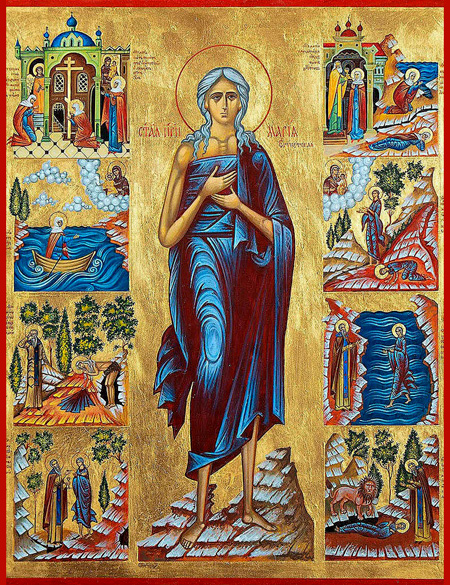
The Venerable Saint Mary of Egypt
(the middle of the V – the beginning of the VI century)
The Venerable Mary of Egypt is one of the greatest saints in the whole history of Christianity. Not many saints are specifically venerated during seven days in the time of a repentant Great Lent before Pascha. Moreover, there is only one woman among them, and this is the Venerable Mary. Her life, as well as the way to God, were extraordinary, and the feat she performed and the fruits of it were exceptional. The description of her life used to be the favorite home reading for many Russians, and during Great Lent, it is read completely at Church. Why is it so? The faith of the Venerable Mary of Egypt is one of the brightest examples of repentance and, at the same time, a reminder of the inexhaustible love of God to a human being.
The Venerable Mary of Egypt lived in the middle of the V-th and the beginning of the VI-th century. When Mary was only twelve, she left her parents and, being free from their supervision, indulged in a sinful life. She led an unchaste life in Alexandria and, “in order to indulge in lust more”, she arrived in Jerusalem; but at the entrance to the Church of the Holy Sepulchre a miracle happened to her. The Power of God did not let her to the shrine. As a result, the yesterday’s sinner realized her fall. Only after a prayer before the icon of the Holy Theotokos, she could have an opportunity of coming inside the church and venerate the Holy Cross. With a sense of the deepest repentance, she abandoned the world and left for a desert, where she spent 47 years of her life in the feats of inner struggle with her passions and became a great saint in the end.
Saint Mary of Egypt began her life by getting herself completely into lust. However, at the end of her life, owing to the feats of asceticism, her soul was so much beyond her body, that she could even walk on the water and rise into the air. She resembled more an angel, than a being made of flesh and blood. She serves as an example of how a true repentance can draw someone from a bottomless pit of sin and bring to a heavenly purity.
READING:
— Life of Venerable Mary of Egypt
— SAINT MARY OF EGYPT
Metropolitan Anthony of Sourozh
— Articles about Venerable Mary of Egypt
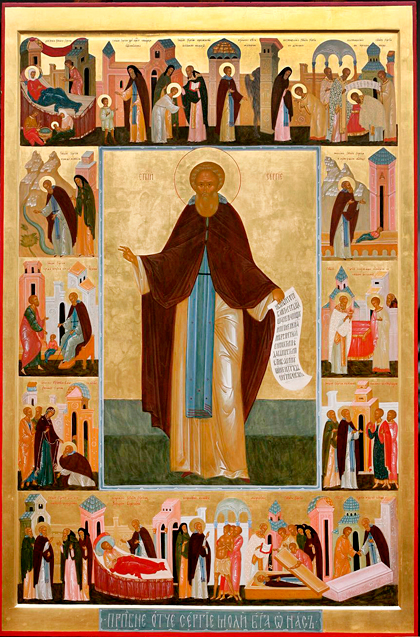
The Venerable Saint Sergius of Radonezh
(1314–1392)
The Venerable Saint Sergius of Radonezh has been one of the most venerated saints since the time of the Ancient Rus until now. He was the founder of several monasteries; and the most famous of them is the Holy-Trinity Saint-Sergius Laura. It is not by accident that Saint Sergius of Radonezh is called “the Abbot of All Russian Land.”
Saint Sergius performed his feats in a difficult time when Rus’ was under the Mongol-Tatar Yoke, but was striving after independence and a strong and united country. Saint Sergius, who was a hermit and had never taken up arms, became a spiritual support in the resistance to the Mongol-Tatar Yoke and inspired the princes and their warriors to a fight for independence of Rus’.
Since Saint Sergius, life in the Russian monasteries began to change: more people were interested in monasticism and were eager to become monks and nuns. The Venerable Sergius with his monastery and disciples was an example and the founder of the monastic; as a chronicler wrote about him, “a head and a teacher of all the monasteries in Rus’.” He made and has been making many people, who get in touch with him, similar to himself in their spiritual essence. He has made generations of monks and nuns strong with his spirit. His disciples and their disciples founded up to 70 monasteries. Saint Sergius’ spiritual progeny was one of the most important spiritual forces, which helped to convert various pagan tribes dwelling in the North and Central Russia, and unite them into one great nation enlightened by the Orthodox Christianity. Our chronicles had the right to call Saint Sergius the Abbot of All Rus’; and the Holy Church honorably and righteously calls him the Champion Leader of the Russian Land!
READING:
— The Life of Venerable Sergius of Radonezh
— Articles
— SAINT SERGIUS OF RADONEZH AND THE HESYCHAST MOVEMENT
Monk Theodore (Stanway)
— STS. CYRIL, SCHEMAMONK, AND MARIA, SCHEMANUN, PARENTS OF ST. SERGIUS OF RADONEZH

The Venerable Saint Gabriel Urgebadze
(1929–1995)
In 2012, the Blessed Gabriel (Urgebadze) was consecrated a saint by the Georgian Orthodox Church, and in 2014 – by the Russian Orthodox Church. This man was our contemporary and he performed a rare feat of a full-for-Christ.
“The Lord humbles and magnifies. When I start to think I am better than others, I put on my diadem and go outside barefooted. People look at me and laugh, and I see what a nothingness I am”, - said Father Gabriel, explaining his behavior only to the closest.
Many people in Tbilisi considered Father Gabriel insane; they humiliated him and laughed at him when he sat on a pile of garbage and said about himself: “I am earth and dust.” Only now do we realize that Father Gabriel through all his extravagance tried to address the people surrounding him: “People, wake up from your pride and hollow vanity!”
He was preaching in the streets and the squares of the Georgian capital, and was building a little church out of improvised materials at hand at the backyard of his house. He adorned the walls of his church with the icons he found at the city dumps.
In 1971, Father Gabriel became the senior priest of the Samtavro Convent. He made a hen house his residence and taught the sisters humility according to his own harsh method. He called people to penance even at the meetings; and always prayed for Georgia and Russia.
The Grace of the Holy Spirit enlightened Father Gabriel and he has never put down anything on paper. His words put themselves down on people’s hearts, guiding them to salvation. The Elder did it forgetting completely about himself. So many lost souls he has saved; so many fallen people he has set on the path of truth; so many souls he has saved from corruption. The Elder had only one objective – to bring his neighbor to God.
READING:
— Elder Gabriel (Urgebadze): His Life, Miracles, and Service after his Death
— ELDER GABRIEL (URGEBADZE): HIS LIFE, MIRACLES, AND SERVICE AFTER HIS DEATH (Articles)
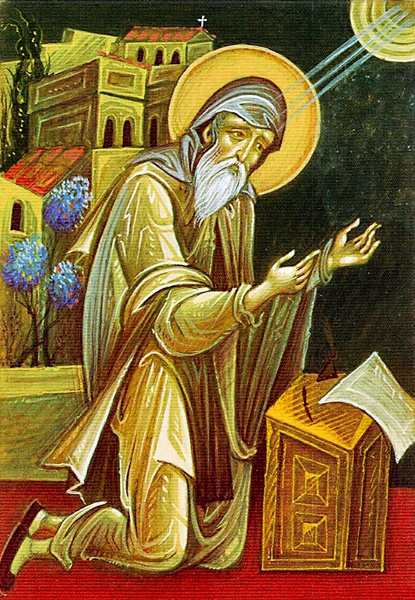
The Venerable Saint Symeon the New Theologian
(949–1022)
Saint Symeon the New Theologian (949, Galatia – 1022, Chrysopolis) was a monk and one of the most remarkable representatives of hesychasm. Along with the two great theologians of the Church – Saint John the Theologian and Saint Gregory the Theologian, Saint Symeon was awarded the title of the New Theologian.
When he was 25, Symeon felt like becoming a monk; he ran away from home and came to the Studionkloster, where he was under the spiritual guidance of Elder Symeon the Devout, whose main feat was the incessant Jesus prayer. For more concentration in prayer, Saint Symeon sought solitude. The states of awe were the fruits of his feat. In time, he reached perpetual and high spiritual enlightenment, which was revealed particularly when he held the Liturgy.
In about 980 Saint Symeon became abbot of the monastery of Saint Mamas and spent 25 year in this capacity. He put in order the neglected household of the monastery and built a church there. The Saint combined kindness and strictness. He kept tirelessly the Commandments, given by God.
In about 1005, the Venerable Symeon placed the monastery under management of Arsenius and retired, residing at the monastery. During that period, he created his theological works, part of which were included in the 5th volume of the “Philokalia.” The major topic of his works is a private prayer in Christ. The Venerable Symeon teaches how to exercise the inner fight, the methods of spiritual improvement and the fight against passions and sinful thoughts. He wrote his instructions for the monastic, “The Theological Chapters”, “A Word on the Three Kinds of Prayer”, “A Word on Faith.” In addition, Saint Symeon was a remarkable church poet. He is the author of “The Hymns of Divine Love” – more than 70 poems full of deep prayerful reflections.
Saint Symeon had a gift of working wonders even in his lifetime. Many wonders took place after his death.
READING:

Saint Great Martyr George the Victorious
(between 275 and 281–303)
Saint Great Martyr George the Victorious is one of the most famous saints of Christianity. In some countries, for example in Georgia and England, he is the most venerated one. Soldiers and agriculturists consider him as their patron saint. People in difficult situations also address him.
Saint George, who lived during the reign of Emperor Diocletianus, was a Roman military commander. He was rich and handsome. Nevertheless, when a violent persecution of Christians began, he showed that he did not care about earthly well-being and acknowledged Jesus as Lord. For that he was subjected to tortures, which none of us cannot even imagine. Saint George was tortured in a pillory, a pile of huge stones was bulked on him, he was broken on the wheel, dug into a pit with caustic lime, white-hot iron boots with sharp nails inside were put on his feet, he was beaten by a scourge and poisoned. But nothing could distract the Great Martyr from his faith to Christ and a prayer to Him. The prayer of the Saint was heard, and the Savior Himself appeared before him promising the crown of martyrdom and the Kingdom of Heaven. Soon the promise was kept and the Great Martyr put to sword and passed away to Our LOrd.
Almost right after the martyric death of Saint George, people began to venerate him as a great saint and wonderworker. His wonders became famous in the Orthodox East first, then, they reached the West. People from Byzantium to the British Isles venerated him as the patron saint of warriors, who gave victory. That is why Saint George is called Victorious.
The relics of the saint dwell in Lydda as per the will. Saint Great Martyr George is venerated and loved throughout the world. He has been known in Russia since ancient times. And the picture of one of his miracles – the defeat of a dragon, who lived in a lake by the Lebanese mountains – is the coat of arms of Moscow.
READING:
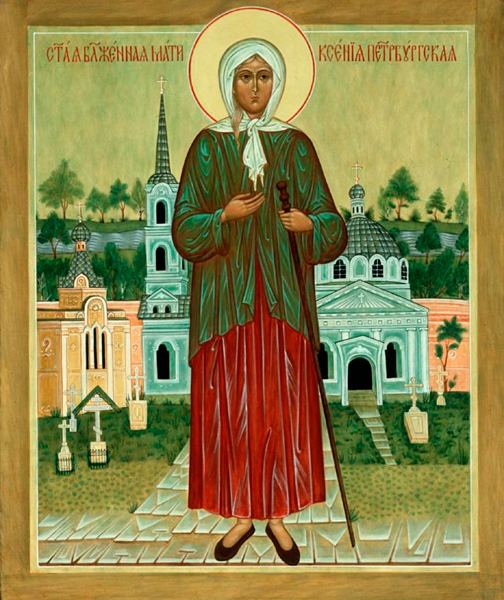
The Blessed Xenia of St. Petersburg
(between 1719 and 1730 – around 1803)
Saint Blessed Xenia of St. Petersburg was considered to be a “quick to help” and a wonderworker even in her lifetime. For the sake of salvation and for love to her neighbors, she became a Full-for-Christ. Owing to her feats, prayer, fasting, pilgrimage, humility and patience when being mocked at, Saint Xenia received a gift of clairvoyance and working wonders from God. She was the wife of Colonel Andrei Feodorovich Petrov, who served as a court chorister. Xenia fell into great grief upon the death of her husband when she was 26 years old. Appearing to have lost her mind from her grief, Xenia distributed her possessions to the poor, and keeping and dressing only in the clothes of her husband, she called herself by her husband’s name: Andrei Feodorovich.
Her biography, the life of service she chose, is an amazing story of love. It is not by chance that the Blessed Xenia became a protectress of those who are in love and who want to have a family. She is a patroness of children and family.
Throughout 45 years after she became a Full-for-Christ, the righteous woman helped everyone who needed her help. Her feat spoke for her kind soul, mildness, absolute self-forgetfulness and clairvoyance.
The Blessed Xenia passed away at the end of the XVIII century. Her body was buried at the Smolenskoye cemetery, where she helped to build a church. Soon after her death, her grave became a place of pilgrimage. Very often Saint Xenia appeared in visions of those people who were in trouble, warned them against danger, and saved them.
The Chapel built in her honor at the Smolenskoye cemetery has always had visitors, even in the time of soviet prohibitions. Nowadays this holy site is visited by many people not only on the day of veneration of Saint Xenia, but people come everyday and get the help of the saint. Her Chapel is spotted with the appreciations of people, who received wonderful help upon her saint prayers.
In June 1988, at the Russian Orthodox Church Local Council, the Blessed Xenia of St. Petersburg was consecrated a saint.
READING:
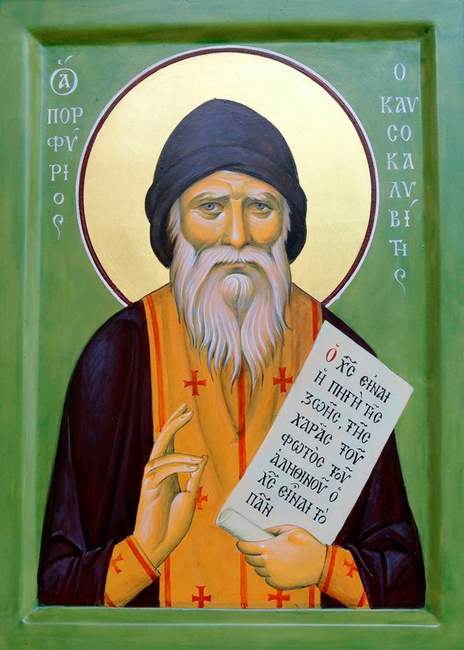
The Venerable Saint Porphyrios of Kafsokalivia
(1906–1991)
Elder Porphyrios of Kafsokalivia one of the most venerated Orthodox ascetics of the XX century. This saint is our contemporary; he lived in the time of technical progress and saw the flight of a human into space. Nevertheless, he did not lose his connection with God, in spite of all the diversity and temptations of the modern world. At the same time, this saint is close and comprehensible to anyone. A kind and permanently smiling face looks at us from the photos; while, in fact, the life of the Elder was not that easy.
Regardless of all his grievances and illness, the Elder worked hard with both his body and soul; he never growled, nor prayed for healing, but gave his spiritual gifts to people instead. His soul was always full of love to God and people.
Father Porphyrios’ spiritual gifts seem incredible in our rational time. He perceived all the things surrounding him supernaturally, in comparison to a person in a fallen state. He could understand the language of birds and knew everything about them, where they came from and where they were flying to. The Elder could see the interior of the earth, the depth of the oceans and unreachable space with his inner eyes. He saw the deposits of coal and oil, the ancient cities buried under the earth, the events of the past, as if he himself witnessed them; he saw the sites blessed with prayer, Angels and demons, and the human soul.
The Elder could look at a person and say what ailed his or her body and soul. The secret thoughts of people were open to him. People were healed upon his touch, while he himself suffered from different illnesses all his life and never asked God to heal him. He never asked anything for himself, but did everything for the sake of Christ and his neighbors. Father Porphyrios was humble and shy, and he only multiplied his virtues with years, without taking credit for them to himself, but always glorifying God.
READING:
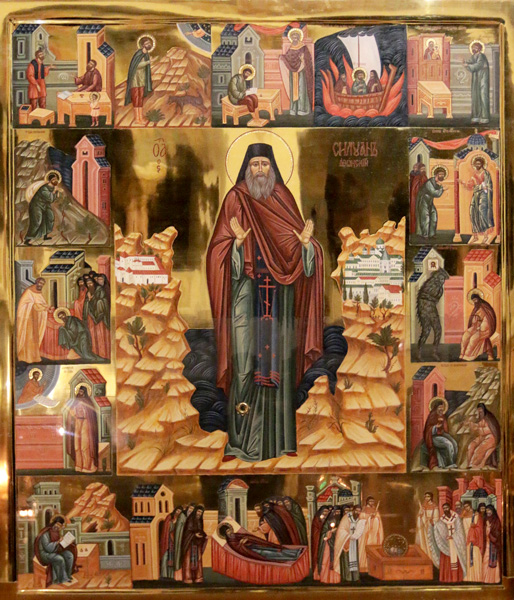
The Venerable Saint Silouan the Athonite
(1866–1938)
The Venerable Saint Silouan the Athonite is one of the most venerable Orthodox saints of the XX century, even though his life may be described in one paragraph. The Venerable Silouan did not die as a martyr. Crowds of pilgrims did not gather at his door. He spent all his monastic life on Athos and was known only to the brethren of his monastery. Nevertheless, Saint Silouan the Athonite is a schemamonk, an elder, an ascetic with a great power of spirit and the witness of God’s love. He was born in a family of peasants in Tambov county; joined the army and served in inferior ranks, then, he lived at the monastery for forty-six years.
For a long time he had been praying and could not help crying, “Lord, have mercy on me”, but God did not hear him. After several months of such prayer, he became exhausted and exclaimed in despair, “You are implacable!” At that moment, something broke inside of him, and for an instant, he vividly saw Christ. A flame filled his heart and his whole body, so that if the vision remained a little longer, he would have died. After that, he could never forget the incredibly humble, limitlessly loving, joyous and inconceivable by this world look of Christ. For the rest of his life, he witnessed that God is love, a limitless and inconceivable love.
The Venerable Silouan used to say, “Those who experienced God’s love, love the whole world and do not grumble over their fate, as a temporary grief for God’s sake brings eternal joy."
READING:
— His Life
— Articles
— ST. SILOUAN THE ATHONITE: HOLY RUSSIAN HERO
Deacon Pavel Serzhantov
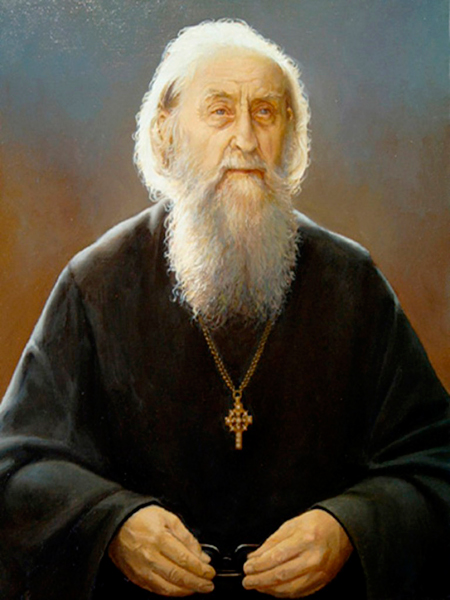
The Venerable Saint Sophrony (Sakharov)
(1896–1993)
Elder Sophrony (Sakharov) is one of the most remarkable ascetics of the XX century. He had such great gifts of God as: being a hesychast, a theologian and a spiritual ascetic writer.
Sophrony was born in Russia; he was brought up spiritually on Mount Athos, where his spiritual father was the Venerable Silouan the Athonite. The last years of his life Saint Sophrony spent in Essex, England, where he founded the Monastery of Saint John the Baptist and passed on his rich spiritual experience to his disciples. Elder Sophrony considered the knowledge of living God an “incomparable gift”, and through it, he represented the image of a true Christian and inspired hundreds and even thousands of people with God’s love.
He did not care about his weak health, but always exhausted himself, giving “blood” in order to obtain the Holy Spirit. That was how he hoped to pass on the sparkle of God’s Light to the numbers of the faithful, who came to him with confidence. Everyone who came wanted to draw some Grace, which poured from the Elder in abundance.
There were many cases of healing people upon the prayers of the Elder in his lifetime and after he passed away.
The books of Archimandrite Sophrony have been translated into more than twenty languages spoken all over the world. His books cause response from a wide range of readers, starting from those people who have no idea about theology, to those who have the highest level of academic interest, from a simple Russian granny to a spectacular scholar of some western university.
The readers in Russia know well his book “The Elder Silouan of Athos”, which many of them read when it was still an underground press. Among the other most important works of Father Sophrony are the book “On Prayer” and “We shall see Him as He is.” As far as the latter is concerned, the Elder said, “… I wrote the whole confession for the whole of my life there. You will find the most important facts of my life in God there…”
READING:
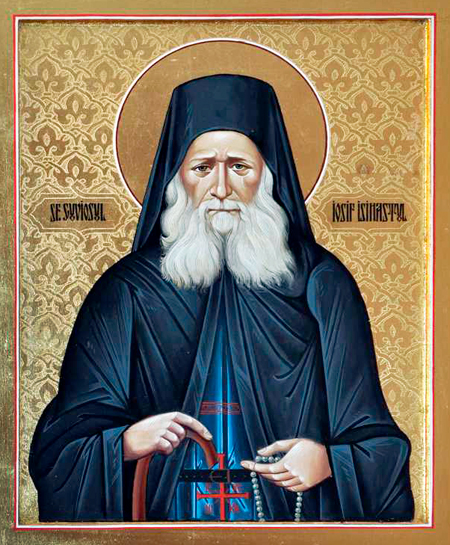
The Venerable Saint Joseph the Hesychast
(1897–1959)
Saint Joseph the Hesychast (or Saint Joseph the Silentiary, or Saint Joseph the Hermit, Francis Kottis in the world) – a shemamonk, ascetic, hesychast and an outstanding person in the spiritual history of the XX century. He is the venerable local saint on Mount Athos and in Romania. Elder Joseph is one of the most prominent representatives of the Athonite monasticism throughout the last decades, and a spiritual guide of many Athonite monks. The 6 out of 20 monasteries on Athos and a number outside of it are related to the names of his disciples.
So far as he came to the Holy Mount, during the first months, which Joseph spent at Vigla, a small isolated place near the Great Laura, he received a priceless Divine gift – a visit of the Uncreated Light and, at the same time, the incessant silent prayer…
Elder Joseph dedicated his life to obtaining the knowledge of the Grace of God through spiritual experience. In his incessant ascetic fighting, he considered laziness (negligence), and not even pride, his key enemy. As Saint Joseph himself said, negligence will not even allow you to see and pick the spiritual fruit (the Grace of God), while your pride steals it from you after you will acquire it.
The words of Saint Joseph Hesychast, which have come down to us in the letters to his spiritual children, are as good as the words of the Holy Fathers. This is possible only when a hermit’s life is as good as that of the Great Fathers. In the published memoirs his personality, life and teaching are brought to light to such an extent, that no one has any doubts about Elder Joseph Hesychast being the greatest spiritual guide of these days. Surely, it happened owing to the fact that the memoires belong to his proximate successor and beloved disciple Ephraim, pro-abbot of the Philotheou Monastery on Mount Athos and the Elder of St. Antony Monastery in Arizona, the US.
READING:
— His Life
— Article
— VIGIL AND DIVINE LITURGY SERVICE TO SAINT JOSEPH THE HESYCHAST

Saint John, Wonderworker of Shanghai and San-Francisco
(1896-1966)
Saint John of Shanghai and San-Francisco (Mikhail Borisovich Maximovich) is the greatest saint of the XX century. He was a Bishop, an ascetic, a prayer, a wonderworker and a missionary.
Saint John was brought up both by the pre-revolutionary Russian Church and the Russian Church Outside Russia. He was born and grew up in Russia, but became a saint outside of it. He lived during the reign of the tsar and in democracy in the West. His body lived in our days, in the XX century, but his soul lived in the ancient times, in the epochs of theology and asceticism. Staying on the sinful earth, he was a true inhabitant of heaven. His big experience, spiritual significance and profound devotion to the Church can help us find the answers not only to spiritual issues of the contemporary world, but also to the national and social problems.
His life is instructive to people of any mindset: the saint was very humble and the people who were close to him revealed his feats and wonders only after his death. Moreover, he loved all the people without exception, but, at the same time, strictly followed the canonical rules of the Orthodox Christianity. This particularity brought many people of different religions to him. There are many cases, when by the aid of Bishop John, people from other confessions converted into Orthodoxy.
Only a while ago he was consecrated a saint, but he has already been venerated universe wide. People in America, Russia, France, Serbia, Greece, Australia, the Netherlands and many other countries pray to the Saint Bishop.
The sainthood of Bishop John of Shanghai is proved by a multitude of wonders he has worked and God’s graceful help rendered to many people upon his prayers. Miraculous signs continue to come from his holy relics upon his prayers, even after the death of the saint.
READING: